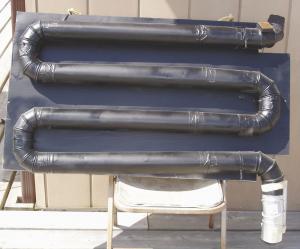2007 - Volume #31, Issue #4, Page #28
[ Sample Stories From This Issue | List of All Stories In This Issue | Print this story
| Read this issue]
Simple Home-Built Solar Heater
 |
The home-built heater can draw air in at 68 degrees F and blow it back out at 110 degrees, he says. McLeod likes the fact that it's self-regulating - meaning that it immediately shuts off when the sun isn't out.
The system measures 24 by 40 in. and hangs suspended from a hook at the top of the 5-ft. sq. window frame.
"It sits on the bottom of the window frame, tipped back slightly because if you can have the whole unit perpendicular to the sunshine, it'll draw heat better," McLeod says.
The unit consists of a piece of 1/4-in. plywood with 3-in. dia. aluminum dryer duct tubing winding across its length four times, thanks to elbows. The tubing is held onto the board with five plastic snap ties running through holes drilled in the wood.
A 14 sq. in., 5-watt solar panel he purchased second hand powers a pair of 2 3/8-in., square, 12-volt DC fans (purchased from an auto parts store), which are similar to computer cooling fans. They fit right inside the aluminum tube structure at opposite ends, in open-ended elbows that face away from each other. One fan draws cool room air in one end of the system, and the other fan pushes hot air out the other end. According to McLeod, they each put out 2 1/2 cu. ft. of air per minute.
Once it was built, McLeod painted the whole thing "flat black" to absorb as much heat as possible from solar rays. He says the tubing does an excellent job of heating up the air as it passes through; however, it would get even hotter if the unit was enclosed in a lead-free glass case.
McLeod used duct tape to hold the tubing and elbows together at the joints. He points out that the air actually travels through 17 1/2 ft. of tubing (including the elbows).
"I thought a larger unit would produce more heat, so I made one twice as big as this one, but it didn't produce any more heat," McLeod points out. "As long as the sun is shining, it can be 20 degrees F outside and the furnace won't come on all day. The heat builds up in the living room enough to keep the furnace from coming on until later in the evening. Best of all, if the sun isn't shining no electricity is generated by the solar panel so the fans don't run."
McLeod spent about $100 on materials for his creation.

Click here to download page story appeared in.

Click here to read entire issue
To read the rest of this story, download this issue below or click here to register with your account number.




